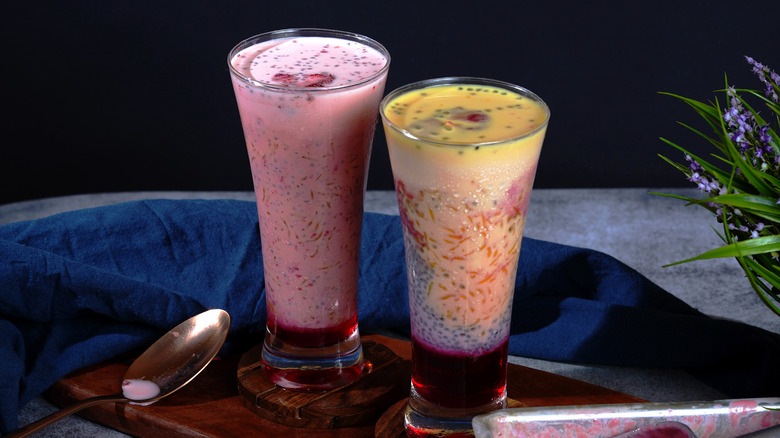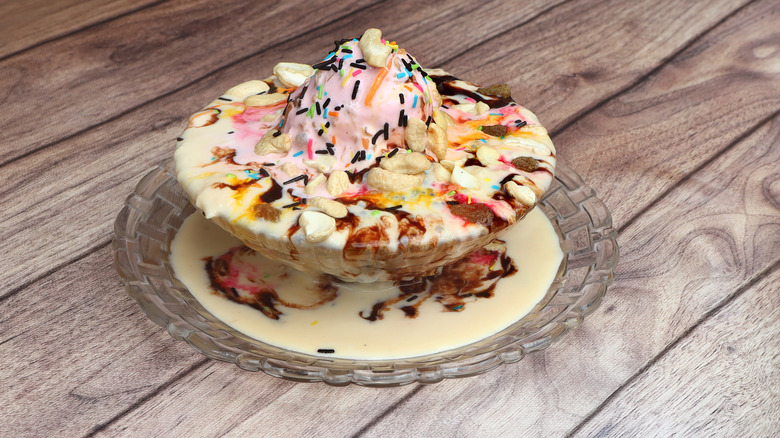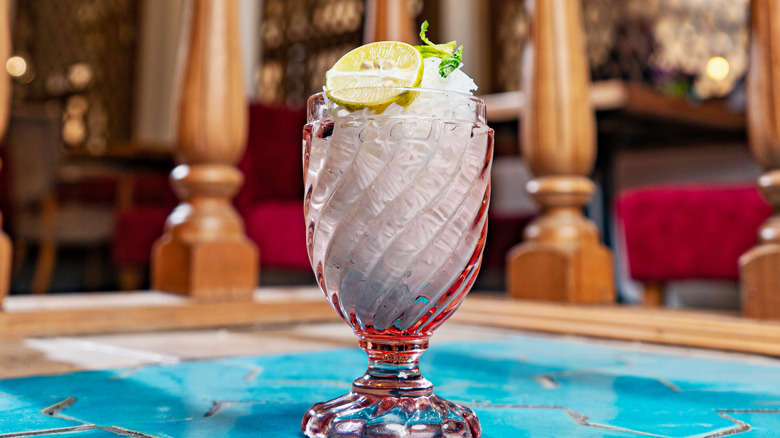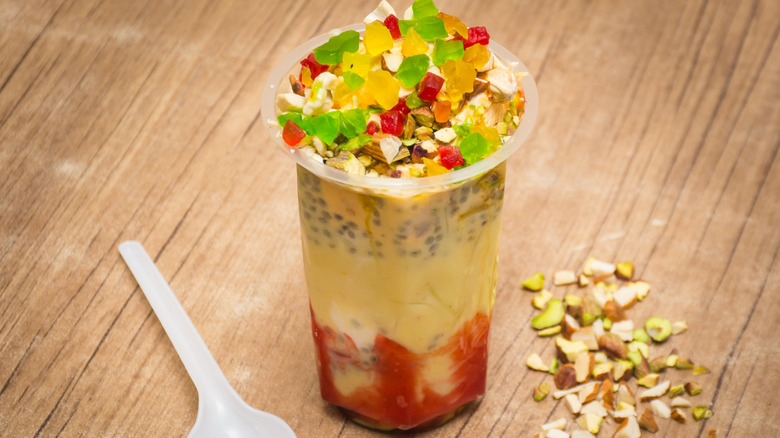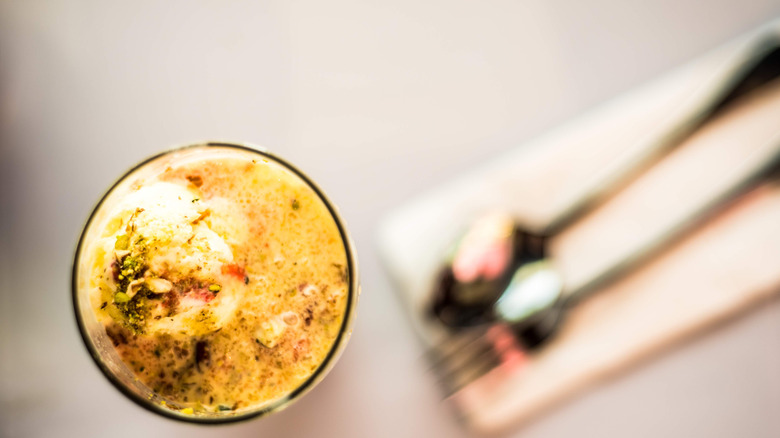Falooda: The Textured Dessert With Varied Origins
We may receive a commission on purchases made from links.
If you type the word "falooda" into Google image search, the results are a hodgepodge of similar but varied-looking sweet desserts, in the form of either a milkshake, ice cream, or drink. Falooda can look like a dressed-up smoothie or a rose-pink bubble tea with ice cream, tapioca pearls, and pistachio toppings. Falooda can even resemble an elaborate fruit custard disguised as a tall drink. Depending on where you enjoy a falooda, it can come in various forms and can be found across India, Pakistan, and the Middle East, and is either enjoyed as a sweet snack, dessert, or a cold drink that is popular during the summer season.
Despite the undeniable aesthetic of falooda, which features bright colors that would make any social media post pop, this popular treat is no newfangled trend. Rather, falooda is an ancient dessert with a rich history that still continues to evolve today. Here's everything you need to know about falooda.
What is falooda and what it tastes like
Falooda is a dessert, usually made up of the ever-versatile vermicelli noodles, basil seeds, ice cream, and sweetened rose-flavored milk. In consistency, it can be more of a fluid and thus is considered a dessert drink, or in other variations thicker — similar to an ice cream. Often, falooda is topped with crushed nuts like pistachio or almonds. Other versions of falooda contain tapioca pearls and custard. No matter which forms falooda comes in, it can be sure to be sweet, cold, refreshing, and for many immigrants, a tasty cultural reminder of home.
One early mention of the dessert in American mainstream media featured falooda as an ice cream flavor. In 1997, The New York Times described falooda as "a much beloved Indian drink, made of skinny noodles, sweet basil seeds and rose water," and maintained that its "cosmetic-like flavor may be an acquired taste for Westerners." However, falooda is more than just a trendy flavor — it's a dessert that dates back over hundreds and hundreds of years ago.
History of falooda
While the exact origins of falooda are unclear, some sources suggest that the dessert originated in Persia. The original dessert that inspired falooda is called faloodeh, the Iranian predecessor which dates back to 400 B.C. However, the Persian faloodeh has remained the same since its form in antiquity and is more of a sorbet. Faloodeh also features cooked vermicelli noodles, but they are frozen in a sugar-and-rose-water combination before being topped with lime juice. Falooda appeared many centuries later — sometime in the 16th century, when the Mughal Empire reached India. The dessert made its way to other countries like Singapore, Malaysia, Nepal, Pakistan, Bangladesh, South Africa, and the East African country Mauritius, where falooda goes by the name of alouda.
Food historians trace falooda back to Mughal Emperor Jahangir, who had a taste for novel foods. There is some dispute as to which royal figure was responsible for the falooda frenzy, as others claim that it was King Nader Shah who introduced the treat to the area. Either way, the dessert that was once reserved for royalty is now enjoyed by the masses in multiple countries.
Variations of falooda and in other cultures
In India, falooda is an iconic drink found in most restaurants and ice cream parlors across the country. Refills are usually free, and the drink is served in a glass, with a milk and rose water syrup base, vermicelli noodles, basil seeds, and pistachios and ice cream. However, there is another version of falooda, called kulfi-falooda, which is more of a traditional dessert rather than a drink. Kulfi, which is pistachio ice cream, is the base on which falooda is added on top. Kulfi-falooda is similar to an ice cream sundae, is presented in a steel bowl or plate, and a spoon is needed to scoop up the pistachio ice cream topped with vermicelli noodles and rose water syrup.
The influence of faloodeh is far spread, as similar iterations of falooda can be found in other countries and cultures: there's halo-halo, a Philippine dessert made with evaporated milk, coconut, yam ice cream, and tropical fruit. In Singapore, cendol is shaved ice covered with coconut milk, condensed milk, and sugar syrup. For some Guyanese, homemade versions of falooda are made up of noodles, sweet milk, cream, and sugar, while other recipes call for condensed milk, evaporated milk, agar agar powder, and vanilla extract.
How to eat and where to find falooda
According to an NPR segment on falooda, the sweet treat was originally meant to be "lingered over with family and friends... to hang out and tell stories as you slowly fill your belly with this cold treat." Some locals also believe that the best way to eat falooda, even if it's served in a glass, is with a spoon — and to dig all the way to the bottom for a complete scoop, ensuring you don't miss out on any of the goodies that make up the dessert.
In regions where its popular, it's fairly easy to find falooda — but if you can't travel to one such country, you can try your luck to see if your local Indian restaurant has falooda on the menu. If you'd like to try your own hand at making falooda, several mixes are available for sale online, like a mango-flavored falooda mix and a rose-flavored one, as well as the basil seeds necessary to make the dessert drink. You can also mix up your own version at home using rose syrup, milk, basil seeds, corn vermicelli, sugar, agar agar, ice cream, and chopped pistachios.
